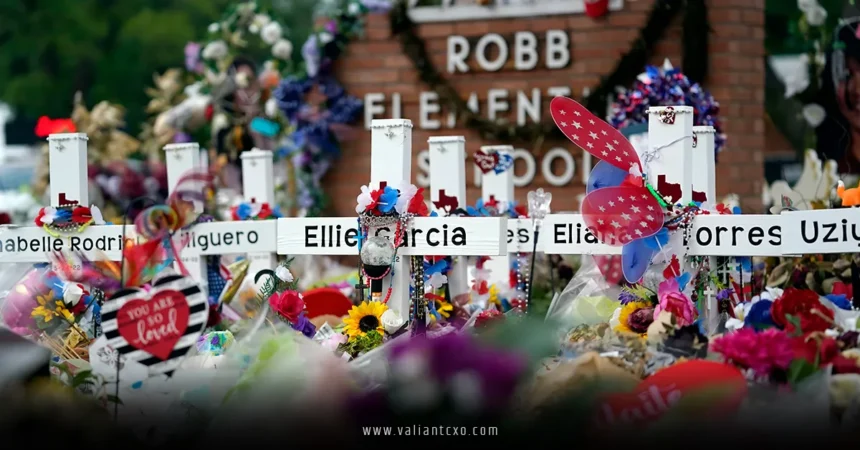Uvalde school shooting rocked a small Texas town to its core on May 24, 2022, when an 18-year-old gunman stormed Robb Elementary School, claiming the lives of 19 children and two teachers in one of the deadliest school attacks in U.S. history. Can you imagine the sheer terror those kids felt, trapped in their classrooms while the world outside seemed frozen? It’s the kind of nightmare that no parent, teacher, or community should ever face, yet it happened right there in Uvalde, Texas—a quiet place where everyone knows each other. As we dive into this story, I’ll walk you through what unfolded that day, why it went so wrong, and how it’s still shaping conversations about safety, guns, and healing today. Stick with me; this isn’t just facts—it’s about understanding the human side of a catastrophe that demands we do better.
Understanding the Roots of the Uvalde School Shooting
Let’s start by peeling back the layers on what might have led to the Uvalde school shooting. The shooter, Salvador Ramos, wasn’t some mysterious figure from out of town; he was a local kid, born in North Dakota but raised in Uvalde. From school records released just recently, we see a troubling spiral. He started as a bright, motivated student in kindergarten, but by middle school, things unraveled. Bullying, harassment write-ups, failing tests—it all piled up like storm clouds. No criminal record, sure, but whispers of animal abuse and online threats to girls painted a darker picture. He dropped out of high school, worked at a Wendy’s, and legally bought two AR-15-style rifles right after turning 18, along with over 1,600 rounds of ammo.
Why does this matter? Because the Uvalde school shooting didn’t happen in a vacuum. Ramos texted a girl in Germany about his plans that morning, shot his grandmother (who survived), and then headed to the school. It’s like a ticking bomb no one defused in time. Experts point to untreated mental health issues, easy access to guns, and a lack of intervention as key factors. Rhetorically speaking, how many red flags do we need before we act? This tragedy screams for better support systems in schools and communities, where signs of trouble aren’t ignored but addressed head-on.
The Harrowing Timeline of the Uvalde School Shooting
Picture this: It’s a typical Tuesday morning in Uvalde, kids excited about the end of the school year. But around 11:10 a.m., everything changes. Ramos shoots his grandmother at home, crashes her truck near Robb Elementary, and starts firing outside the school. By 11:33 a.m., he’s inside through an unlocked door—yeah, unlocked—and unleashes over 100 rounds into connected classrooms 111 and 112 in just minutes. Kids dialing 911 from inside, begging for help, while the gunman lurks.
Officers arrive quickly, by 11:35 a.m., but here’s where it gets infuriating. They retreat after taking fire, grazing two cops. Instead of pushing in as an active shooter protocol demands, they treat it like a barricaded suspect. Minutes tick by—12:03 p.m., 19 officers huddled in the hallway. Parents outside, desperate, pleading with police to storm in; some even get tackled or handcuffed for trying to help. Finally, at 12:50 p.m., Border Patrol tactical agents breach the door and take Ramos down after 77 agonizing minutes.
That timeline? It’s not just numbers; it’s lives hanging in the balance. Imagine being a parent, hearing gunshots, and watching cops stand by. The Uvalde school shooting exposed a delay that could have saved lives, turning what should have been a swift response into a prolonged horror.
Honoring the Victims of the Uvalde School Shooting
We can’t talk about the Uvalde school shooting without centering the victims—the innocent souls stolen too soon. Nineteen fourth-graders, ages 9 to 11, full of dreams and giggles. Names like Amerie Jo Garza, who loved art; Xavier Lopez, a budding athlete; and Tess Mata, who adored TikTok dances. Then the teachers: Eva Mireles, 44, a dedicated educator with 17 years under her belt, and Irma Garcia, 48, who shielded her students and whose husband died of a broken heart days later.
Seventeen others injured, including kids with physical scars and everyone with emotional ones. Funerals stretched over weeks, the town draped in grief. Memorials popped up—crosses, flowers, teddy bears—reminders of lives cut short. The Uvalde school shooting wasn’t statistics; it was families shattered, like a puzzle missing pieces forever. We owe it to them to remember not just how they died, but how they lived—vibrant, loved, irreplaceable.
The Controversial Law Enforcement Response in the Uvalde School Shooting
If there’s one aspect of the Uvalde school shooting that boils blood, it’s the police response. Over 376 officers from various agencies swarmed the scene, including 149 Border Patrol and 91 state troopers. Yet, they waited. Chief Pete Arredondo, the school district’s police head, called the shots—or rather, didn’t. He saw it as a barricade, not an active threat, delaying breach for gear and keys.
Bodycam videos released in 2025 show parents screaming, “Go in! Our kids are dying!” while officers fist-bump or apply hand sanitizer. One mom got arrested trying to rescue her child. It’s like watching a fire rage while firefighters debate the hose. The DOJ’s 2024 report nailed it: “cascading failures” in leadership, tactics, and training. Lives could have been saved if they’d followed active shooter protocols—rush in, neutralize the threat. Instead, kids bled out, calling 911 in vain.
Investigations and Legal Aftermath of the Uvalde School Shooting
In the wake of the Uvalde school shooting, probes poured in. The Texas House dropped a 77-page bombshell in July 2022: systemic failures everywhere. Then the DOJ’s massive 600-page review in January 2024 echoed that, blasting the shift from active shooter to barricade mindset. CBP’s own investigation followed in September 2024.
Fast-forward to 2024: Arredondo and officer Adrian Gonzales indicted on child endangerment—10 and 29 counts each. They pleaded not guilty, trials looming in October 2025. Lawsuits flew: against gun makers like Daniel Defense for negligent marketing, Meta and Activision for alleged influence, and a $2 million settlement from the city for families. Records dumps in 2025 revealed more—shooter’s school decline, internal comms—fueling calls for accountability. The Uvalde school shooting sparked reforms, but justice feels slow, like molasses in winter.
Community Healing and Long-Term Impact After the Uvalde School Shooting
Uvalde, a tight-knit Hispanic-majority town of 15,000, hasn’t been the same since the school shooting. Robb Elementary closed for good, set for demolition; a new Legacy Elementary opens fall 2025. Fundraisers raised millions, scholarships flowed, but mental health needs linger. Three years on, survivors and families battle trauma, seeking therapy amid barriers.
Parents like those in the videos, pleading outside, now advocate for change. It’s like a wound that scabs but never fully heals. The Uvalde school shooting united the community in grief, but also in resilience—memorials, vigils, acts of kindness. Yet, harassment of families post-reports shows the road to recovery is bumpy.
Broader Lessons: Gun Control and School Safety Since the Uvalde School Shooting
The Uvalde school shooting ignited fierce debates. How does an 18-year-old buy assault rifles so easily? It led to the Bipartisan Safer Communities Act in June 2022—the biggest gun reform in decades, boosting background checks and mental health funding. Texas upped officer training, mandating 16 hours every two years for school shootings.
But is it enough? Analogies to fire drills abound—schools drill kids yearly, yet cops get less prep? The Uvalde school shooting highlights gaps: better locks, mental health support, red-flag laws. Politically, it’s gridlock—some push bans, others arm teachers. What if we treated guns like cars, with tests and insurance? This tragedy motivates us to rethink safety, ensuring no more Uvaldes.
Preventing Future Tragedies Like the Uvalde School Shooting
So, how do we stop another Uvalde school shooting? Start with awareness—spot signs early, like Ramos’ threats. Communities need robust mental health resources; schools, secure doors and active shooter drills that include cops. Legislation matters: expand background checks, raise purchase ages for rifles.
Parents, talk to your kids about bullying and emotions. It’s like building a fortress—not just walls, but vigilant guards. The Uvalde school shooting teaches us prevention is collective; ignore it, and history repeats.
In wrapping up this deep dive into the Uvalde school shooting, we’ve seen the horror, the failures, and the flickers of hope. From the timeline’s delays to the victims’ legacies, it’s a call to action. Don’t let this fade—push for change, support affected families, and hug your loved ones tighter. If we learn from Uvalde, we honor those lost by building a safer tomorrow. Let’s make sure no family endures this pain again.
FAQs on the Uvalde School Shooting
- What exactly happened during the Uvalde school shooting?
The Uvalde school shooting occurred on May 24, 2022, when Salvador Ramos entered Robb Elementary and killed 19 students and two teachers over 77 minutes before being stopped. - Why was the police response to the Uvalde school shooting so criticized?
Law enforcement delayed entry, treating it as a barricade instead of an active shooter, leading to cascading failures as outlined in DOJ reports. - Who were the victims in the Uvalde school shooting?
Nineteen fourth-grade students and teachers Eva Mireles and Irma Garcia were killed, with 17 others injured in the tragic event. - What legal actions followed the Uvalde school shooting?
Officers Pete Arredondo and Adrian Gonzales face child endangerment charges, and families sued gun makers and tech companies for negligence. - How has the community recovered from the Uvalde school shooting?
Uvalde is building a new school, providing mental health support, and advocating for gun reforms, though healing remains ongoing.
For More Updates !! : valiantcxo.com


